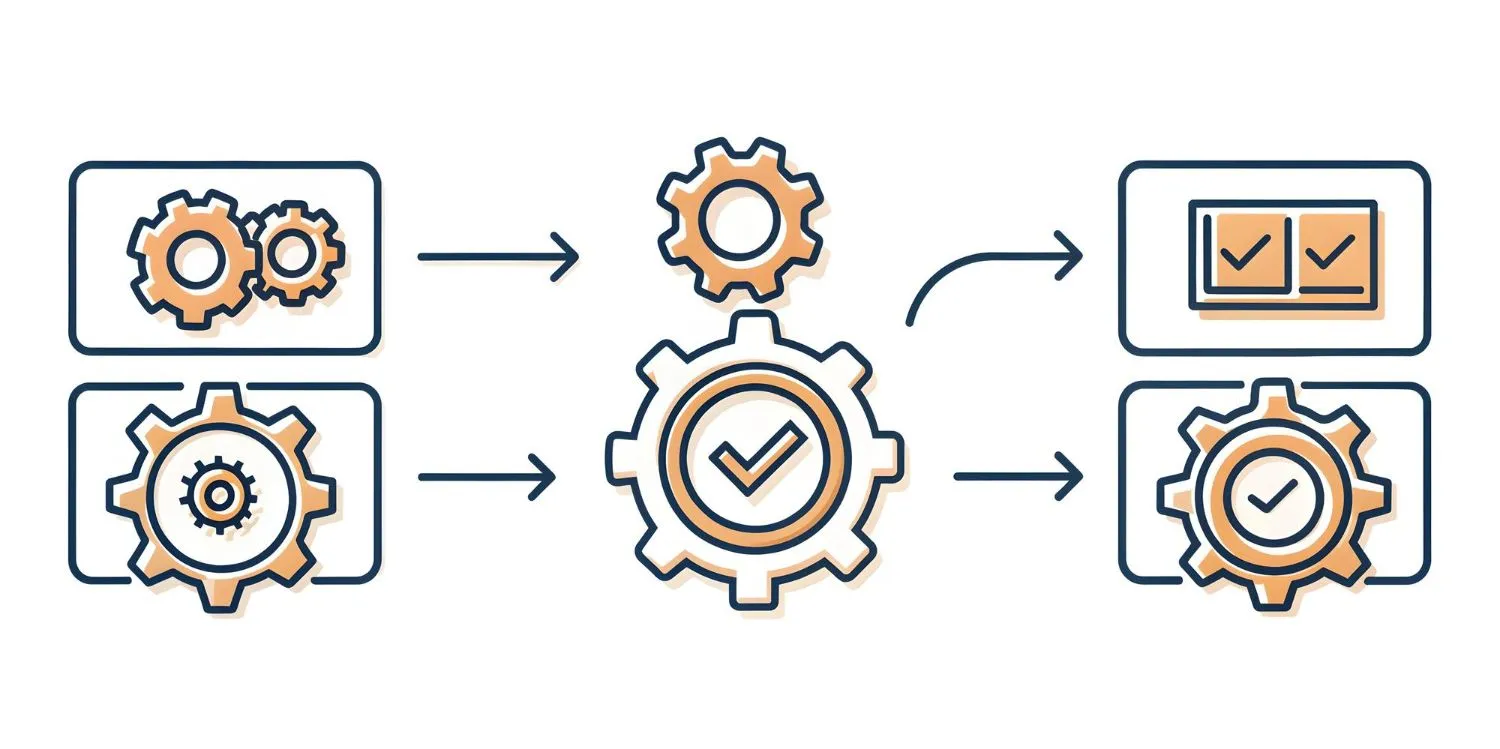Business process automation is a necessary component of modern business management. It involves using technology to perform repetitive tasks and processes that were previously performed manually by employees. This allows companies to increase efficiency, reduce costs, and minimize the risk of human error.
What is business process automation?
Business process automation is the use of technology to streamline and optimize daily operations in a company. It involves identifying repetitive tasks and replacing them with automated systems that can perform these tasks faster, more accurately, and more efficiently than humans.
Imagine a restaurant where waiters manually write down orders on cards and then run to the kitchen to hand them over. Automating this process could involve introducing a tablet system where waiters enter orders electronically, and they automatically appear on a screen in the kitchen. This not only speeds up service, but also eliminates the risk of communication errors between the dining room and the kitchen.
The most important benefits of business process automation
- Increased efficiency: Automation allows tasks to be completed faster, which translates into greater productivity throughout the organization.
- Cost Reduction: By eliminating manual, time-consuming tasks, companies can significantly reduce operating costs.
- Improved quality: Automated processes are less susceptible to human error, leading to higher quality products and services.
- Better data analysis: Automation systems often collect valuable data that can be used to make more informed business decisions.
- Increased customer satisfaction: Faster, more accurate service translates into higher levels of customer satisfaction.
Business process automation is not just a trend, but a necessity in today's rapidly changing business environment. Companies that effectively implement automation gain a competitive advantage and are better prepared for the challenges of the future.
Areas that can be automated – real-life examples
Business process automation can be implemented in many areas of a company's operations, bringing significant benefits and improvements. In which areas can it work?

Finance and accounting
In the area of finance and accounting, automation can significantly improve processes, reducing the time needed to perform routine tasks and minimizing the risk of errors.
Imagine a small business that manually enters hundreds of invoices into the accounting system every month. This process is time-consuming and error-prone. With automation, the company can implement an OCR (Optical Character Recognition) system that scans invoices and automatically enters the data into the accounting system. This not only saves time, but also minimizes the risk of errors when entering data.
Human Resources
Automation in the HR department can significantly improve recruitment, onboarding and work time management processes.
Manufacturing companies employing hundreds of shift workers often struggle with the problem of effective scheduling. Implementing an automated shift planning system that takes into account employee preferences, legal requirements and production needs can save dozens of hours of work for managers and increase employee satisfaction.
Customer service
Customer service automation can significantly improve the speed and quality of customer response. This is especially important in highly competitive industries.
For example, an online electronics store can implement a chatbot that automatically answers frequently asked questions about order status, returns policy, or product specifications. This way, customers receive immediate answers 24/7, and the customer service team can focus on more complex cases.
Logistics
Automation in logistics can optimize warehousing and transportation processes, increasing efficiency and reducing costs.
A distribution center can implement an automated parcel sorting system based on barcodes and conveyors. This makes the sorting process faster, more accurate, and requires less manual labor, which translates into faster order fulfillment and lower operating costs.
Quality control and verification
Automating quality control processes can significantly increase the accuracy and speed of product verification.
A factory producing electronic components can implement an automated quality control system using cameras and artificial intelligence. This system can detect even the smallest defects on high-speed production lines, which would be impossible to achieve with manual inspection.
How to implement automation step by step?
To implement automation, you should analyze your business processes, choose the right automation tools, implement the solution or outsource it. The final step should be thorough testing. Ultimately, automation is supposed to make our lives easier, and processing returns of incorrectly sent packages by an automated system will likely bring more problems than benefits.

Step 1: Business Process Analysis
The first step in implementing automation is a thorough analysis of existing business processes. This is a fundamental step that will allow you to identify areas for improvement and determine the potential benefits of automation.
- Process Mapping: Create detailed diagrams that illustrate each process in your company.
- Identify bottlenecks: Identify where processes are least efficient or most time-consuming.
- Cost analysis: Estimate the costs associated with the current way of implementing processes.
- Determining automation potential: Identify processes that can be automated to the greatest benefit of the business.
Imagine a small bakery that wants to optimize its order-taking process. The owner spends several hours a day answering phones and writing down orders manually. Analysis of this process shows that it is time-consuming, error-prone, and limits the ability to accept orders outside of the bakery’s opening hours.
Step 2: Selecting Automation Tools
Once you have identified the processes to automate, the next step is to select the appropriate tools and technologies that will help you achieve this goal.
- Define requirements: Create a list of the functionalities you need in your automation system.
- Market Research: Analyze the automation solutions available on the market.
- Cost assessment: Compare the costs of different solutions, taking into account not only the purchase price but also the implementation and maintenance costs.
- Testing: Test your chosen tools to make sure they meet your expectations.
Returning to our bakery, the owner could decide to implement a simple online ordering system. After analyzing the available options, he chooses a solution that allows customers to place orders via a website, and the orders are automatically transferred to the bakery system.
Step 3: Implementation and Testing
The final step is to implement the chosen solution and conduct thorough testing to ensure that the automation works as expected.
- Implementation planning: Develop a detailed implementation schedule, taking into account potential risks and ways to minimize them.
- Employee training: Prepare and conduct training for employees who will use the new system.
- Gradual implementation: Consider introducing automation in stages, starting with less critical processes.
- Testing: Conduct comprehensive testing to ensure that automated processes are working correctly and effectively.
- Collect feedback: Regularly collect feedback from employees and customers on the new system.
- Optimization: Based on the information collected, make any necessary adjustments and improvements.
The bakery implements an online ordering system, starting with internal testing, where employees pretend to be customers and place trial orders. After making sure the system works properly, the owner introduces it to a limited group of regular customers. He collects feedback from them and makes any necessary adjustments. Only after this stage is the system made available to all customers.
Implementing automation is a process that requires time, patience, and a systematic approach. However, the benefits it brings - in the form of increased efficiency, reduced costs, and improved customer service - are worth the effort. Remember that automation is not a one-time action, but a continuous process of improvement and optimization that should evolve with the development of your business.
Process automation using AI
Artificial intelligence (AI) is revolutionizing the way companies approach business process automation. With the ability to learn and adapt, AI systems can perform tasks that previously required human intelligence, opening up new opportunities for efficiency and innovation. By analyzing large amounts of data, recognizing patterns, and making decisions in real time, AI can significantly optimize business processes, reduce costs, and improve overall company performance.
Customer service through chatbots
AI-powered chatbots are fundamentally changing the way businesses communicate with customers by offering instant, 24/7 customer service. Using natural language processing (NLP), chatbots can understand customer intent and provide relevant, personalized responses.
This allows for quick resolution of basic queries and issues without involving human agents, improving customer service and increasing customer satisfaction. Chatbots can also proactively engage customers by offering product recommendations, tips, and support, further enriching the customer experience and building brand loyalty.
Customer Data Analysis
AI can analyze vast amounts of customer data to draw valuable insights that can be used to personalize offers and improve the customer experience. By analyzing customer behavior, preferences, and purchasing history, AI systems can create detailed customer profiles and segment them based on various criteria.
This allows companies to better understand customer needs and desires and provide them with highly personalized recommendations, offers, and communications. By leveraging the power of AI to analyze customer data, companies can increase customer satisfaction, build lasting relationships, and ultimately increase sales and profits.
Marketing process automation
AI can significantly streamline and personalize marketing efforts by automating many aspects of advertising campaigns. Using customer data and behavior, AI can create highly targeted campaigns that deliver the right content to the right audience at the right time. This can include email personalization, product recommendations, dynamic bid optimization for pay-per-click (PPC) campaigns, and automated ad content generation.
By automating these processes with AI, marketers can save time, reduce costs, and increase the overall efficiency of their marketing efforts while delivering more personalized and engaging experiences to customers.
Data analysis automation
AI can automate the data analysis process, drawing valuable insights from massive amounts of information much faster than humans. Using machine learning techniques such as deep learning, AI systems can autonomously discover patterns, anomalies, and trends in data without the need for manual programming.
This allows companies to more quickly gain meaningful insights that can drive decision-making and innovation. By automating the tedious and time-consuming aspects of data analysis, AI frees analysts and decision-makers to focus on more strategic tasks, such as interpreting results and developing action plans. As a result, companies can be more agile, make better decisions, and ultimately achieve better business outcomes.
Using different IT systems for automation
Make and n8n
Make (formerly Integromat) and n8n are powerful workflow automation platforms that allow you to connect different apps and services without having to write code.
Imagine a small marketing agency that wants to automate its lead generation process. Using Make, the agency creates a scenario where new entries from a website contact form automatically go into the CRM system, while simultaneously creating a task in the project management tool and sending a notification on Slack to the appropriate sales team member.
Additionally, Make can automatically categorize leads based on specific criteria and trigger personalized email campaigns. This saves the agency time, minimizes the risk of missing a lead, and ensures a quick response to every inquiry.
CRM Systems
Customer relationship management (CRM) systems are essential for automating sales and customer service processes.
Consider a company that sells B2B software. It uses an advanced CRM system to automate its entire sales cycle. When a prospect downloads an e-book from the company’s website, the CRM system automatically creates a new record, assigns lead scoring based on behavior on the site, and triggers a sequence of personalized emails. The system tracks customer interactions, automatically escalating leads to the sales team when they reach a certain level of engagement.
Once a sale is closed, the CRM automatically initiates the onboarding process, sending relevant materials and scheduling meetings with the support team. This allows the company to handle significantly more leads while providing a personalized experience to each prospect.
Financial and accounting systems
Automation in the area of finance and accounting can significantly reduce the time needed for routine tasks and minimize the risk of errors.
Imagine a mid-sized manufacturing company that implements an automated finance and accounting system. The system automatically imports data from supplier invoices (using OCR technology), matches them to purchase orders and initiates the payment approval process. At the same time, the system monitors customer payment due dates, automatically sending reminders and escalating overdue payments to the collection department.
At the end of the month, the system automatically generates financial reports, taking into account depreciation, accruals and other complex accounting operations. This allows the finance department to focus on data analysis and strategic planning, instead of tedious data entry and manual calculations.
Conclusions and additional tips
- Automation is a continuous process: Implementing automation is not a one-time action, but a continuous process of improvement and optimization.
- Balance between technology and the human factor: Successful automation requires finding the right balance between the capabilities of technology and the skills and experience of employees.
- Personalization and flexibility: The best automation solutions are tailored to the unique needs and processes of an organization.
- The importance of data: Automation relies on data, so ensuring high data quality and proper data management is crucial.
- Impact on organizational culture: Implementing automation often requires a change in mindset and way of working throughout the organization.
Additional tips
- Start small: Don't try to automate everything at once. Start with smaller, easier-to-implement projects to build trust and experience.
- Invest in training: Provide employees with appropriate training so they can use new tools and processes effectively.
- Monitor and measure results: Establish clear KPIs and regularly monitor the effects of automation so you can quickly respond to any issues.
- Be open to innovation: Follow the latest trends and technologies in automation to stay up to date with new opportunities.
- Work with experts: Consider working with experienced companies or consultants who specialize in business process automation.
Summary
Business process automation is a powerful tool that can revolutionize the way a company operates. By using technology, including artificial intelligence, companies can optimize and streamline many aspects of their business - from customer service and marketing to data analysis and financial processes.
Implementing automation is a process that requires careful analysis, planning and gradual implementation of changes. The key is to find the right balance between technology and the human factor and to adapt solutions to the unique needs of the organization.
The benefits of automation are significant - increased efficiency, cost reduction, better quality of services and higher customer satisfaction. However, success depends on continuous improvement, monitoring results and openness to innovation.
Automation is not a choice, but a necessity. Companies that effectively implement automation gain a significant competitive advantage and are better prepared for the challenges of the future.
Frequently asked questions
What processes can be automated?
Virtually any repetitive business process that is based on specific rules or patterns can be automated. The most common processes that are automated are administrative and office processes, data management and reporting, customer service, financial and accounting processes, human resources management, and production and logistics processes.
What does business process automation mean?
Business process automation is the use of technology to perform repetitive tasks and processes with little or no human intervention. The goal is to increase efficiency, reduce costs, and minimize human error.
What are the steps to process automation?
The steps taken to automate processes most often include: identifying processes for automation, analyzing and mapping current processes, designing an automated process, selecting appropriate tools and technologies, implementing the solution, testing and optimization, training employees, and continuous monitoring and improvement.
Why is it worth automating business processes?
Automation of business processes allows for: increasing efficiency and productivity, reducing operating costs, minimizing human errors, improving the quality and consistency of services, easier scaling of operations and improving customer and employee satisfaction.

Adam Naworski



